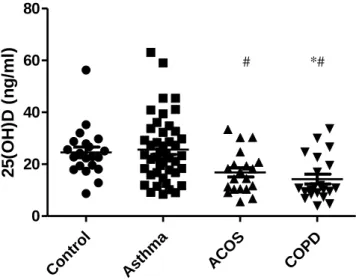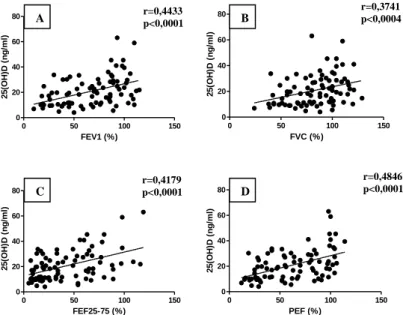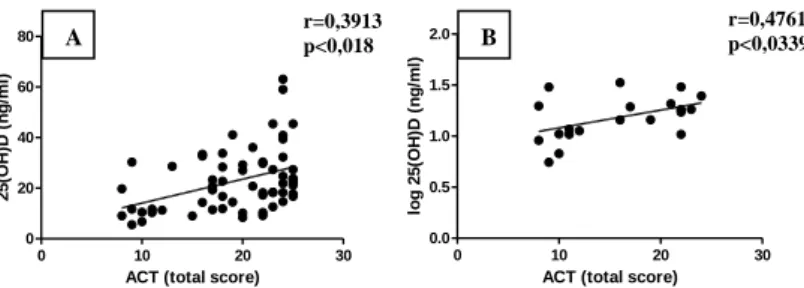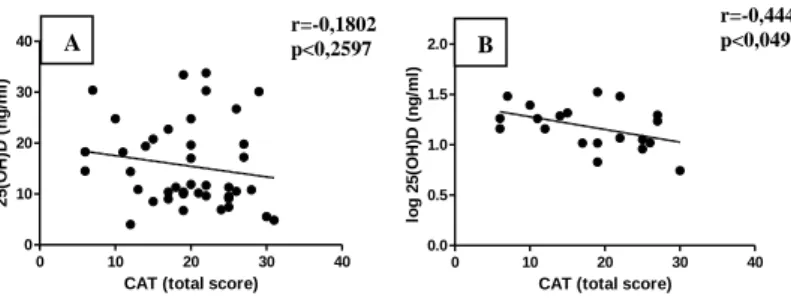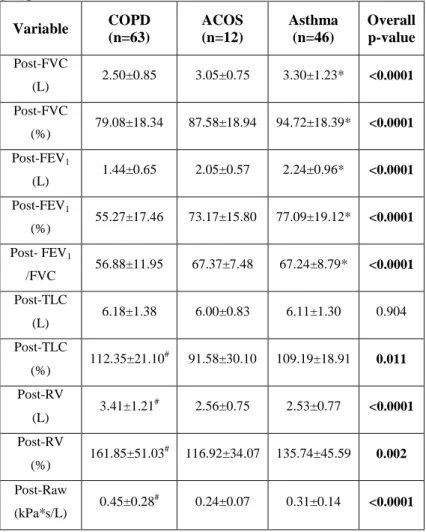Vitamin D and clinical characteristics in asthma-COPD overlap syndrome
Ph.D. theses Balázs Odler M.D.
Semmelweis University Doctoral School of Clinical Medicine
Supervisor: Veronika Müller M.D., Ph.D.
Official reviewers:
Péter Vajer M.D., Ph.D.
Csaba Böcskei M.D., Ph.D.
Head of the final examination committee:
András Szabó M.D., doctor of HAS Members of doctoral committee:
Dávid Becker M.D., Ph.D.
Balázs Antus M.D., doctor of HAS
Budapest 2016
1
1. INTRODUCTION
Obstructive lung diseases (OLDs) represent a major health problem worldwide due to their high prevalence associated with elevated socioeconomic costs. Both asthma bronchiale and chronic obstructive pulmonary disease (COPD) are chronic obstructive ventilatory disorders with airway inflammation; however, they are separate nosological entities based on their development, diagnostic- and therapeutic approaches and prognostic features. There are OLD patients who are sharing features of both diseases; including asthma patients with a history of smoking characterized by more sever lung function deterioration or COPD patients with allergic disease and partial reversibility of airway obstruction.
Based on their high prevalence, these diseases may coexist and can be defined as the coexistence of increased variability of airflow in a patient along with incomplete reversible airway obstruction. This phenotype is called asthma-COPD overlap syndrome (ACOS). Based on previous studies the prevalence of the syndrome might be 15-45%
among OLD patients. ACOS is a clinical and scientific challenge as the majority of these patients have been excluded from clinical and pharmacological trials, thus well-defined clinical characteristics and therapeutic approaches are lacking.
The physiological role of vitamin D is to regulate calcium and phosphorus homeostasis and preserve bone health. However, a growing body of evidence both from animal and human studies suggest that vitamin D may also be important for a variety of non- skeletal actions. These include cell proliferation, inflammation,
2
immune responses or processes that may contribute to the pathogenesis of a wide range of acute and chronic diseases. Its role in lung physiology is also known, as it plays a regulatory role of cell function or immune responses. There are several studies showing that vitamin D deficiency is common in COPD and is associated with worse lung function parameters. In asthma, normal level of vitamin D is linked with less exacerbations and the supplementation of the vitamin may be effective in the prevention of exacerbations.
Moreover, higher vitamin D levels were associated with improved lung function, better glucocorticoid therapy response, and less airway hyperreactivity in asthmatic patients. Both, in COPD and asthma, vitamin D has the potential to influence the onset of the disease by influencing lung development in utero and in early life. It is axiomatic that there has been an explosion of vitamin D research in chronic lung diseases however; there is no data available on the role of vitamin D in the ACOS patient group and its possible role in disease pathogenesis or influence on clinical characteristics.
3
2. OBJECTIVES The main aims of our studies were:
1. Investigate and compare the clinical characteristics of patients with obstructive lung diseases (asthma bronchiale, COPD and ACOS).
2. Assessment of vitamin D deficiency in patients with ACOS and vitamin D levels in patients with different types of obstructive lung diseases.
3. Assessment of the correlation between vitamin D and lung function parameters in OLD and ACOS patients.
4. Assessment of the influence of vitamin D level on the quality of life and disease specific control in OLD and ACOS patients.
5. Define risk factors associated with vitamin D deficiency in patients with OLDs.
6. Assessment of bronchodilator response to salbutamol in patients with COPD and ACOS.
7. Define clinical features of reversible and nonreversible patients.
8. Identify which clinical factors are able to influence the bronchodilator response.
9. Patient’s perception on how easy it is to use rapid-acting β₂- agonist salbutamol according delivery formulations.
4 3. METHODS
Study populations
We involved four groups into our cross-sectional study, investigating the role of vitamin D: patients with asthma bronchiale (asthma), COPD, ACOS and healthy control subjects. In the airway reversibility study, COPD and ACOS patients were compared to asthmatic patients. In the vitamin D study 44 asthmatic, 21 COPD, 20 ACOS and 21 control subjects were enrolled. In the airway reversibility study 151 patients had been enrolled, of whom 121 showed airway obstruction, thus their results were evaluated in the final analysis. Asthmatic, COPD and ACOS patients were followed at the Department of Pulmonology, Semmelweis University. Patients with clinical diagnosis of COPD with any grade of severity had been diagnosed according to the Global Initiative for Chronic Obstructive Lung Diseases (GOLD) classification, while asthmatic patients were defined according to the current GINA (Global Initiative for Asthma) and national guideline. Patients with simultaneous diagnosis of asthma and COPD were classified as ACOS using criteria from the GINA and GOLD documents. Healthy control subjects were all volunteers.
For the presence of vitamin D insufficiency and deficiency, the following criteria were used: vitamin D sufficiency > 30 ng/ml;
vitamin D insufficiency ≤ 30 ng/ml and ≥ 20 ng/ml; vitamin D deficiency < 20 ng/ml.
5
Patients were enrolled regardless of their smoking history or habit.
Data on sex, age, diagnosis, body mass index (BMI) and clinical data were retrieved from their medical files.
Spirometry measurements
Lung function was measured by means of electronic spirometer and body plethysmography (PDD-301/s, Piston, Budapest, Hungary) according to the current guidelines. In cases of confirmed obstruction, 400µg salbutamol delivered via the Easyhaler® dry powder inhaler (DPI) (Buventol Easyhaler®, Orion Pharma) was administered and measurements were repeated 15-20 minutes after inhalation.
COPD quality of life and asthma control evaluation
The health status in COPD and ACOS patients was evaluated through a COPD Assessment Test (CAT®) – Hungarian version. We measured COPD and ACOS patients’ dyspnea severity using a modified Medical Research Council (mMRC) questionnaire. Patients were classified according to GOLD document (GOLD A,B,C,D categories). Asthma control was assessed by the Hungarian Asthma Control Test (ACT), recommended by the current guidelines.
Device preference for inhaled rapid-acting β₂-agonists
Patients were asked about their former use of rapid-acting β₂- agonists. Moreover, patients answered questions comparing Easyhaler® DPI or classic pressurized metered dose inhaler (pMDI) with respect to the easiness of use, perceived bronchodilator effect and effect on sputum expectoration.
6
Sample collection and laboratory procedures
Blood samples were collected from all OLD patients and healthy volunteers and stored at –80°C until measurement. The serum 25(OH)D concentrations were measured using commercially available enzyme-linked immunosorbent assay (ELISA) assays (DiaSorin S.p.A., Saluggia, Italy) according to the manufacturers’
instructions. The detection limit of 25(OH)D was 4.0 ng∙ml-1. The measurements were performed at the Department of Laboratory Medicine, Semmelweis University. Blood cell counts and standard laboratory measurements results were retrieved from patients’ charts.
Statistical analysis
Data were analyzed using Kruskal-Wallis test, chi-square test, one- way analysis of variance (ANOVA) test, Spearman and Pearson correlation analyzes, furthermore Dunns’ and Newman-Keuls post hoc tests according to the features of the data and the studies.
Univariate and multivariate regression analysis were performed to identify risk factors associated with vitamin D deficiency and reversibility. The results are expressed as the mean ± standard error of mean, if not stated otherwise. Significance value (p-value) was set at 0.05.
7 4. RESULTS
Results of the vitamin D study Clinical data
The mean age of participants in control and asthma groups was lower compared to COPD and ACOS groups (38.00 [range: 25-71]
years and 44.84 [range: 22-85] years vs 66.33 [range: 43-86] years and 65.45 [range: 50-83] years; p<0.0001). The highest BMI was observed in ACOS patients, however significant difference was only present between COPD and ACOS groups (24.33±0.95 vs 29.12±1.45 kg/m2; p<0.05). The majority of asthma patients were never-smokers (n=41; 93%). while there were mostly ex-smokers in the COPD and ACOS groups (n=15; 71% and n=14; 70%). The highest number of comorbidities was noted in the COPD group (2.19 [range: 0-4]).
Change of serum 25(OH)D levels in study groups
Thirty-six % (16/44) of asthmatic, 76% (16/21) of COPD and 60%
(15/20) of ACOS patients had vitamin D deficiency. As shown in Figure 1 the mean serum 25(OH)D level was significantly lower in ACOS and COPD groups compared to the asthma group. There was no significant difference between COPD and ACOS groups;
likewise, no difference between the control group and asthma and ACOS groups was noted (Figure 1). Serum 25(OH)D was not influenced by the daily inhaled corticosteroid (ICS) dose used (no ICS use/low, -medium, -and high dose).
8 Control
Asthma
ACOS
COP D 0
20 40 60 80
2 5 (O H )D ( n g /ml )
Relationship between 25(OH)D level and lung function parameters
The comparison between asthma and ACOS groups showed a significant difference with regard to forced expiratory volume in 1 second (FEV1), forced vital capacity (FVC), forced expiratory flow at 25-75% (FEF25-75) and peak expiratory flow (PEF) % predicted (all p-values <0.0001) but did not show difference in Raw%
predicted (p=0.29). Comparing ACOS and COPD groups, significantly lower FEV1, FVC, FEF25-75, PEF and Raw% predicted lung function parameters were observed in COPD patients (all p- values were <0.001)
Figure 1: 25(OH)D levels in different study groups.
*p<0.05 vs control; #p<0.05 vs asthma
*#
#
9
r=0,4433 p<0,0001
r=0,3741 p<0,0004
r=0,4179 p<0,0001
r=0,4846 p<0,0001
Positive correlation was found between the serum 25(OH)D level and FEV1% predicted (r=0.4433; p<0.0001; Figure 2/A). FVC%
predicted (r=0.3741; p=0.0004; Figure 2/B). FEF25-75% predicted (r=0.4179; p<0.0001; Figure 2/C) and PEF% predicted (r=0.4846;
p<0.0001; Figure 2/D) lung function parameters, furthermore negative correlation was found with Raw% predicted value (r=- 0.2988; p=0.0079; no figure added). However, only the asthmatic group showed a positive correlation with PEF (r=0.3196; p=0.0345), when data were separately analyzed (all p-values were >0.05).
0 50 100 150
0 20 40 60 80
FEV1 (%)
25(OH)D (ng/ml)
0 50 100 150
0 20 40 60 80
FVC (%)
25(OH)D (ng/ml)
0 50 100 150
0 20 40 60 80
FEF25-75 (%)
25(OH)D (ng/ml)
0 50 100 150
0 20 40 60 80
PEF (%)
25(OH)D (ng/ml)
Figure 2: Relationship between 25(OH)D levels and lung function parameters in OLD patients.
A B
C D
10
r=0,3913 p<0,018
r=0,4761 p<0,0339
Relationship between 25(OH)D level and diseases specific quality of life scores
Our results showed a significant difference in the mMRC total score between ACOS and COPD groups (1.80 [1-3] vs 3.57 [2-4] – mean [range]; p<0.0001).
ACOS patients had better disease control, than asthmatic patients (ACT: 20.95 [9-25] vs 15.60 [8-24] – mean [range]; p<0.0001).
Furthermore, positive correlation between ACT total scores and serum 25(OH)D level (r=0.3913; p=0.018; Figure 3/A) were observed. The ACT total score showed no correlation in the asthmatic group, but significant correlation between worse disease control associated with lower serum level 25(OH)D was observed in the ACOS group (r=0.4761; p=0.0339; Figure 3/B).
0 10 20 30
0 20 40 60 80
ACT (total score)
25(OH)D (ng/ml)
0 10 20 30
0.0 0.5 1.0 1.5 2.0
ACT (total score)
log 25(OH)D (ng/ml)
The mean CAT total scores showed no difference in COPD and ACOS groups (21.14 [12-31] vs 17.95 [6-30] – mean [range];
p=0.11). Concerning all patients with COPD (COPD and ACOS) no
A B
Figure 3: Correlation between 25(OH)D level and ACT total score in asthmatic and ACOS patients together (A) and in ACOS patients alone (B)
11
r=-0,1802 p<0,2597
r=-0,4446 p<0,0495
significant relationship between 25(OH)D level and CAT total scores (r=-0.1802; p=0.2597; Figure 4/A) were observed. Negative correlation of higher CAT total scores with decreased serum 25(OH)D in ACOS group (r=-0.4446; p=0.0495; Figure 4/B) was noted, however this tendency was not observed in the COPD group alone.
0 10 20 30 40
0 10 20 30 40
CAT (total score)
25(OH)D (ng/ml)
0 10 20 30 40
0.0 0.5 1.0 1.5 2.0
CAT (total score)
log 25(OH)D (ng/ml)
Risk factors associated with vitamin D deficiency
The clinical diagnosis of COPD and ACOS are risk factors for vitamin D deficiency, while the diagnosis of asthma bronchiale is a risk factor for vitamin D insufficiency. In respect of clinical parameters of OLD patients, age, FEV1%, and PEF <80% predicted, ACT total score, atopic history, low-dose ICS use has been identified as a risk factor for vitamin D deficiency. However, only atopy reached a statistically significant level as an independent negative risk factor (OR: 0.176; 95% CI: 0.036-0.862; p=0.032).
Figure 4: Correlation between 25(OH)D level and CAT total score in COPD and ACOS patients together (A) and in ACOS patients alone (B)
A B
12 Results of the airway reversibility study
Clinical data
The analysis included 72 women and 49 men. The COPD patients were older than asthmatic patients (62.8±11.8 vs 50.2±21.0 years;
p<0.05). Thirty percent (n=37) of the patients were smokers, 38%
(n=46) of them ex-smokers, while 38 (32%) patients never smoked.
Out of the smokers group thirty-two (89%) patients were COPD patients.
COPD patients had significantly lower baseline FEV1 (1.32±0.61 vs.
1.98±0.86 L; p<0.0001), FEV1% predicted (50.60±16.74 vs 67.93±16.71%; p<0.0001) and FEV1/FVC ratio (56.56±11.60% vs 63.97±7.58%; p<0.0001) than patients with asthma. COPD patients had higher mean values for airway resistance (0.62±0.46 vs 0.42±0.17 kPa/s; p<0.05) and residual volume (167.56±55.99 vs 150.35±48.62%; p<0.05) than patients with asthma, while the total lung capacity (TLC) values showed no difference. There was no difference between the BMI of the COPD and asthmatic patients.
The group of patients with ACOS had a similar mean age as the patients with COPD, but had lung function values very close to the control group of patients with asthma (FEV1 [1.93±0.56 vs 1.32±0.61 liter; p<0.05], FEV1% predicted [68.50±14.88 vs 50.60±16.74 %; p<0.05], FEV1/FVC ratio [65.74±7.39 vs 56.56±11.60; p<0.05]). The mean BMI of ACOS patients did not differ significantly as compared to the other patient groups, but a tendency to elevated values was noted.
13 Postbronchodilator (PB) lung function
The mean lung function values of the patients after inhalation of 400 µg salbutamol via Easyhaler® DPI device are shown in Table 1.
Table 1: postbronchodilator lung function parameters in the study groups.
Variable COPD (n=63)
ACOS (n=12)
Asthma (n=46)
Overall p-value Post-FVC
(L) 2.50±0.85 3.05±0.75 3.30±1.23* <0.0001 Post-FVC
(%) 79.08±18.34 87.58±18.94 94.72±18.39* <0.0001 Post-FEV1
(L) 1.44±0.65 2.05±0.57 2.24±0.96* <0.0001 Post-FEV1
(%) 55.27±17.46 73.17±15.80 77.09±19.12* <0.0001 Post- FEV1
/FVC 56.88±11.95 67.37±7.48 67.24±8.79* <0.0001 Post-TLC
(L) 6.18±1.38 6.00±0.83 6.11±1.30 0.904 Post-TLC
(%) 112.35±21.10# 91.58±30.10 109.19±18.91 0.011 Post-RV
(L) 3.41±1.21# 2.56±0.75 2.53±0.77 <0.0001 Post-RV
(%) 161.85±51.03# 116.92±34.07 135.74±45.59 0.002 Post-Raw
(kPa*s/L) 0.45±0.28# 0.24±0.07 0.31±0.14 <0.0001 Data expressed as mean±SD, if not stated otherwise. Significant differences are highlighted in bold. *p<0.05 asthma vs COPD; #p<0.05 COPD vs. asthma
14
The mean improvement in FEV1 was +0.12L in the COPD group, which was significantly lower than the reversibility in the control asthma group (+0.26L). In the ACOS group, the mean increase in FEV1 was exactly the same as in the asthma group (+0.26L).
Reversibility was seen in 41 patients (34%). A higher proportion of the asthma and COPD patients demonstrated reversibility compared with patients in the ACOS group. A total of 21 patients with COPD (33%) improved >12% and ≥200ml FEV1, compared with 18 patients with asthma (39%). Only two out of 12 patients in the ACOS group (17%) showed reversibility.
Influence of clinical factors on reversibility
Smoking status did not influence reversibility. Only weight was a single significant predictor of reversibility. The nonreversible COPD patients had significantly higher mean weight, BMI and higher FEV1/FVC ratio. A comparison between reversible and nonreversible COPD patients is shown in Table 2.
Table 2: characteristics of reversible and nonreversible COPD patients
Variable reversible COPD
nonreversible COPD
p- value
Age (years) 61.6 62.4 0.790
Male (n) 10 20 0.783
Female (n) 13 30 0.783
Current and ex-
smoker (n) 17 44 0.969
15 Never smoker
(n) 2 5 0.969
Weight (kg) 64.0 77.1 0.003
Height (cm) 165.4 166.7 0.564
BMI (kg/m2) 23.3 27.7 0.001
FEV1 (L) 1.38 1.62 0.188
FEV1 (%) 52.1 60.4 0.068
FEV1/FVC 53.7 62.5 0.010
FVC (L) 2.58 2.53 0.798
FVC (%) 80.7 77.9 0.537
Significant differences are highlighted in bold.
Patients’ evaluation of salbutamol Easyhaler® DPI device The majority of the patients were using an inhaled rapid-acting bronchodilator (RABA) at the time of the study. Daily bronchodilator use was the highest among patients with COPD. Most patients evaluated the DPI Easyhaler® device better in all questions compared to the classical pMDI devices and scored the DPI device to have a greater bronchodilating capacity than a pMDI, to be more effective than a pMDI in inducing expectoration, and in helping in morning activities. Inhalator perceived differences were not influenced by reversibility.
16
5. CONCLUSIONS The studies confirmed the following:
1. In our studies ACOS affected mainly the elderly population, with higher weight and smoking history. ACOS patients had better baseline lung function parameters, than our severe COPD patient group. ACOS patients showed worse disease control, than asthmatic patients and had more symptoms. ACOS patients had less comorbidities as compared to COPD patients, but more than in asthmatic patients.
2. Vitamin D deficiency is a common feature of ACOS and is similarly affecting severe COPD patients, while asthmatic patients showed mainly vitamin D insufficiency.
3. Decreased level of vitamin D was associated with worse lung function parameters in OLD patients. However, when analyzing data for single disease groups, only PEF% predicted in asthma group showed association with vitamin D level.
4. In patients with asthma (asthma and ACOS), ACT total scores showed positive correlation with vitamin D level. Analyzing the two groups (asthma vs ACOS) separately, there was a positive correlation between poorer disease control and lower vitamin D levels only in ACOS patients. Additionally, there was a negative association between CAT total scores and vitamin D in ACOS patients, but not in COPD.
5. The clinical diagnosis of COPD and ACOS are risk factors for vitamin D deficiency, while asthma bronchiale is associated mainly with vitamin D insufficiency. We did not find any other independent
17
clinical risk factor except for atopy associated with decreased risk for vitamin D deficiency.
6. Asthma and ACOS patients have more notable postbronchodilator reversibility, than COPD patients. However, smaller proportion of ACOS patients showed reversibility as compared to asthma and COPD patients.
7. Reversible COPD patients have higher bodyweight, BMI and FEV1/FVC ratio.
8. Smoking status did not influence reversibility. Only bodyweight was a single significant predictor of reversibility among clinical factors.
9. The patients found the salbutamol delivered via DPI (Easyhaler®) easy to use and easier than pMDI. Inhalator perceived differences were not influenced by reversibility.
18
6. BIBLIOGRAPHY OF THE CANDIDATE’S PUBLICATIONS
Publications related to the dissertation:
1. Odler B, Ivancsó I, Somogyi V, Benke K, Tamási L, Gálffy G, Szalay B, Müller V. Vitamin D deficiency is associated with impaired disease control in asthma-COPD overlap syndrome patients. Int J Chron Obstr Pulm Dis. 2015; 10: 2017-2025.
2. Müller V, Gálffy G, Orosz M, Kováts Z, Odler B, Selroos O, Tamási L. Characteristics of reversible and non-reversible COPD and asthma and COPD overlap syndrome patients: an analysis of salbutamol Easyhaler data. Int J Chron Obstr Pulm Dis. 2016; 11: 93-101.
3. Odler B, Müller V. Asztma-COPD overlap szindróma. Orv Hetilap. 2016; 157(33): 1304-1313.
Publications not related to the dissertation:
1. Odler B, Bikov A, Streizig J, Balogh C, Kiss E, Vincze K, Barta I, Horváth I, Müller V. CCL21 and IP-10 as blood biomarkers for pulmonary involvement in systemic lupus erythematosus patients. Lupus. 2016 Sep 10. doi:
10.1177/0961203316668418.
2. Odler B, Cseh Á, Constantin T, Fekete G, Losonczy G, Tamási L, Benke K, Szilveszter B, Müller V. Long time enzyme replacement therapy stabilizes obstructive lung disease and
19
alters peripheral immune cell subsets in Fabry patients. Clin Respir J. 2016 jan 13. doi: 10.1111/crj.12446.
3. Benke K, Ágg B, Szabó L, Szilveszter B, Odler B, Pólos M, Cao C, Maurovich-Horvat P, Radovits T, Merkely B, Szabolcs Z. Bentall procedure: quarter century of clinical experiences of a single surgeon. J Cardiothorac Surg. 2016; 11:19. doi:
10.1186/s13019-016-0418-y.
4. Farkas Á, Jókay Á, Füri P, Balásházy I, Müller V, Odler B, Horváth A. Computer Modelling as a Tool in Characterization and Optimization of Aerosol Drug Delivery. Aerosol and Air Quality Research. 2015; DOI: 10.4209/aaqr.2015.03.0144 5. Benke K, Ágg B, Mátyás G, Szokolai V, Harsányi G,
Szilveszter B, Odler B, Pólos M, Maurovich-Horvát P, Radovits T, Merkely B, Nagy ZB, Szabolcs Z. Gene polymorphisms as risk factors for predicting the cardiovascular manifestations in Marfan syndrome. Role of folic acid metabolism enzyme gene polymorphisms in Marfan syndrome. Thromb Haemost. 2015;
114(4): 748-756.
6. Agg B, Benke K, Szilveszter B, Pólos M, Daróczi L, Odler B, Nagy ZB, Tarr F, Merkely B, Szabolcs Z. Possible extracardiac predictors of aortic dissection in Marfan syndrome. BMC Cardiovasc Disord. 2014; 14(1): 47.
7. Odler B, Constantin T, Fekete G, Tamási L, Müller V. Légúti obstrukció hátterében álló ritka kórkép: Fabry-kór. Med Thor 2013; 66(1): 31-35.
20
8. Vincze K, Odler B, Müller V. A szisztémás lupus erythematosus pulmonális manifesztációi. Orv Hetilap. 2016;
157(29): 1154-1560.
9. Benke K, Sayour AA, Ágg B, Radovits T, Szilveszter B, Odler B, Németh BT, Pólos M, Oláh A, Mátyás Cs, Ruppert M, Hartyánszky I, Maurovich-Horvat P, Merkely B, Szabolcs Z.
Génpolimorfizmusok. mint rizikófaktorok a Marfan-szindróma kardiovaszkuláris manifesztációinak előrejelzésében. Card Hungarica. 2016; 46: 76-81.
10. Müller V, Horváth G, Tamási L, Eszes N, Bohács A, Vincze K, Kováts Z, Lázár Z, Odler B, Kornafeld A, Erdélyi T, Somogyi V, Losonczy G. Obstruktív tüdőbetegségekben alkalmazott inhalációs gyógyszerek célpontjai: receptorok a légúti felszín sejtjein. Med Thor. 2015; 68(1): 6-12.
11. Benke K, Ágg B, Szilveszter B, Odler B, Nagy ZB, Pólos M, Merkely B, Szabolcs Z. A Marfan-szindróma molekuláris patomechanizmusa. Card Hungarica. 2014; 44: 3-9.
